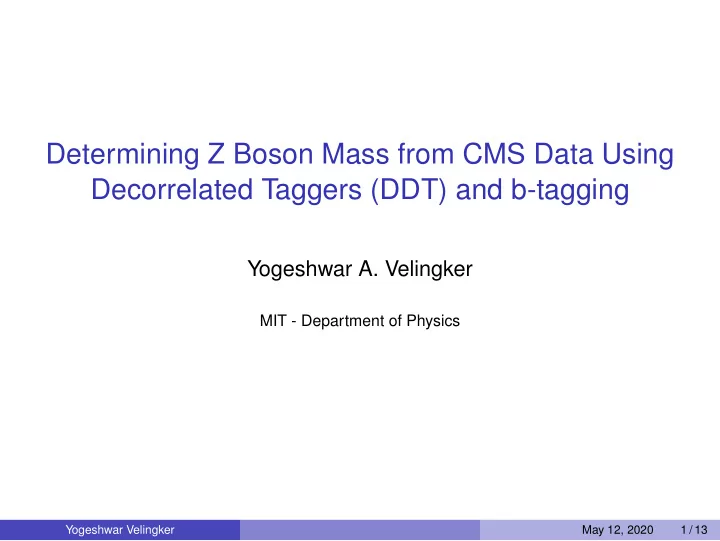

Determining Z Boson Mass from CMS Data Using Decorrelated Taggers (DDT) and b-tagging Yogeshwar A. Velingker MIT - Department of Physics Yogeshwar Velingker May 12, 2020 1 / 13
W and Z bosons: mediators of the weak nuclear force W + and W − bosons have positive/negative charge, respectively ◮ Antiparticles of each other Z boson has neutral charge and is its own antiparticle After finding W boson mass using data from CMS, we want to find the Z boson mass Yogeshwar Velingker May 12, 2020 2 / 13
Jets are the eventual decay products of W and Z bosons W and Z bosons have various decay products, including quarks ( W → q ¯ q and Z → q ¯ q ) Jet: decay products originating from quarks/gluons W and Z bosons product jets with two separate “prongs” Use this process to find W and Z boson mass Yogeshwar Velingker May 12, 2020 3 / 13
CMS data consists mostly of background processes Data is from 8 TeV collisions performed at the Large Hadron Collider Gluon-gluon scattering and quark-antiquark annihilation make up the bulk of the processes Need to remove these processes from the data in order to separate the signal from the background Use decorrelated taggers (DDT) Yogeshwar Velingker May 12, 2020 4 / 13
Separating out the Z boson: b-tagging Yogeshwar Velingker May 12, 2020 5 / 13
Separating out the Z boson: b-tagging Decay into b-quarks at a much higher rate than W bosons b-tag: tagging of jets originating from bottom quarks, using CSV algorithm Yogeshwar Velingker May 12, 2020 6 / 13
10.0 5.0 Events 17.5 15.0 12.5 0.0 7.5 2.5 q 0.0 b-tag probability 1.0 0.8 0.6 0.4 0.2 q b-tag values for W vs Z (Monte Carlo) W → q ̄ Z → q ̄ Yogeshwar Velingker May 12, 2020 7 / 13
3 0 6 5 4 q 2 1 b-tag probability q 1.0 0.9 0.8 0.7 0.6 0.5 Events b-tag values: Z more represented for higher b-tag (Monte Carlo) W → q ̄ Z → q ̄ Yogeshwar Velingker May 12, 2020 8 / 13
150 400 80 90 100 110 120 Soft drop mass [GeV] 50 100 70 200 250 300 350 Cut on b-tag value: Z boson bump emerges Events, τ 21 < 0.70, csv > 0.85 Yogeshwar Velingker May 12, 2020 9 / 13
50 250 80 90 100 110 120 Soft drop mass [GeV] 70 100 150 200 Cut on b-tag value: Z boson bump emerges Events, τ 21 < 0.70, csv > 0.90 Yogeshwar Velingker May 12, 2020 10 / 13
50 175 80 90 100 110 120 Soft drop mass [GeV] 25 70 75 100 125 150 Cut on b-tag value: Z boson bump emerges Events, τ 21 < 0.70, csv > 0.95 Yogeshwar Velingker May 12, 2020 11 / 13
125 75 Data Background+signal fit: χ 2 Events 175 150 70 100 50 m = 92.76 ± 0.55 GeV, σ = 0.99 ± 0.55 GeV 25 Mass 120 110 100 90 80 Background fit Fitting the bump: Gaussian on top of Gaussian ν = 1.29 Yogeshwar Velingker May 12, 2020 12 / 13
Conclusion Our value of the Z boson mass is close to the accepted value (91 . 19 ± 0 . 0021 GeV) Noisy data, due to tight cut Deep learning Yogeshwar Velingker May 12, 2020 13 / 13
Recommend
More recommend